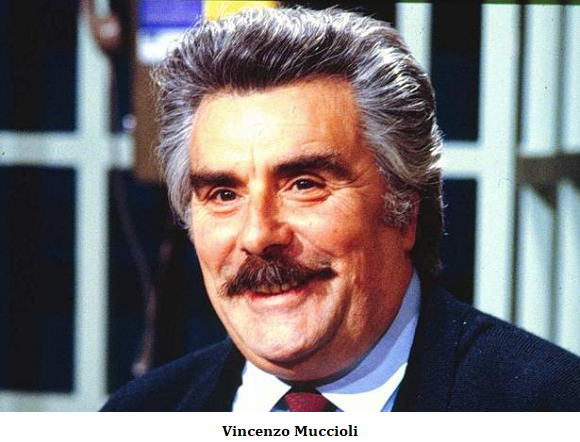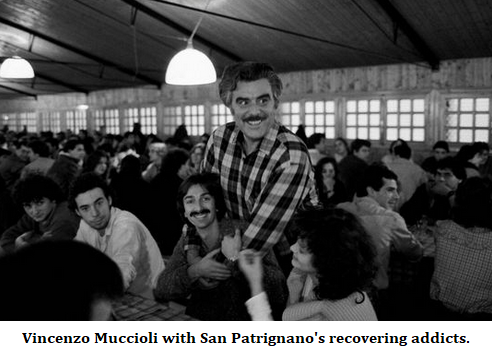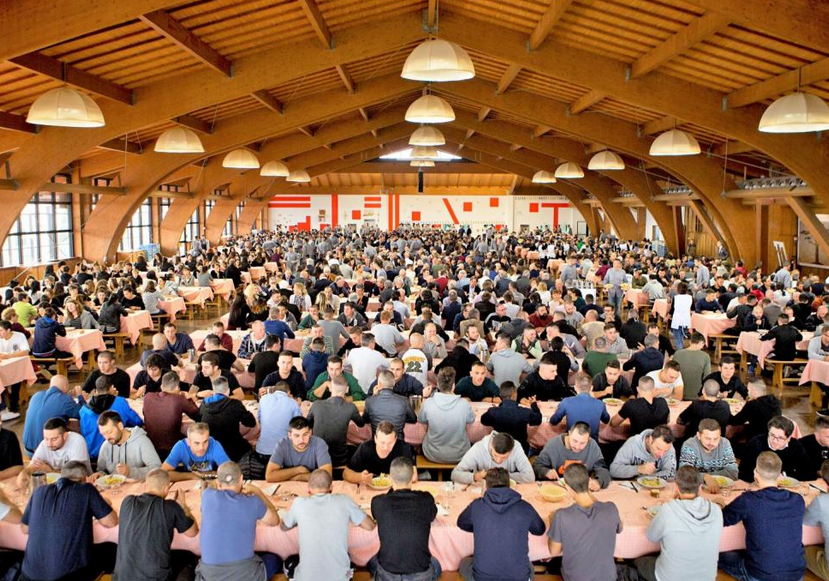
While the international debate about drug addiction rages on – is it a brain disease, or a behavioural choice – and what to do about it, a self-sustaining community in Italy is regularly touted as the ideal solution for addict treatment. San Patrignano (SanPa to its adherents) sits on a hilltop with a view of Adriatic, not far from Rimini. It shelters more than 1200 tossicodipendenti who spend three and a half years without pay and without their phones learning useful trades and crafts. The SanPa drug rehabilitation programme treats addiction not as a disease but as a community problem and has spawned copycat programmes from San Francisco to London and to Geraldton in Western Australia.
High quality in the products of its workshops and kitchens is an embodiment of its philosophy of Bello in everything it does. But not everything was beautiful at the beginning. This is the story of the dark chapter that nearly brought the experimental community crashing down.
We had not long taken up residence in Italy in the exciting ’90s when blaring newspaper headlines outlined a scandal of brutality, murder and criminal obfuscation. Its horrors were greeted as a change from the constantly rotating stories of Mafia crimes in the south, and in the north, the unmasking of corporate embezzlement and political skulduggery in the mani puliti investigations.
On May 5, 1989, a white VW Golf drove up a dusty track on the lower slopes of Mt. Vesuvius. The driver and his companion dragged a bundle out of the boot and left it on a village discarica – rubbish dump. The following day the bundle was found to be the body of Roberto Maranzano, a 38-year-old former commercial traveller, whose wife and two children lived in Palermo, Sicily. He had been beaten so badly his body was scarcely identifiable. That area around Naples is a stronghold of the Camorra and its drug traffickers; the local police assumed he was just another addict who had not paid.
But Maranzano was not a victim of the local drug scene. Nor had he come from his home in Palermo. He had in fact been living in the idyllic little “closed” community of San Patrignano, 400km to the north. There, in the hills between San Marino and Rimini on the Adriatic coast, two-thousand drug addicts seeking to kick the habit lived and worked on what had been hailed throughout Europe as a model farm rehabilitation centre.
Police interviewed the founder-father of San Patrignano, the well-groomed and urbane Vincenzo Muccioli, but he convinced them that Maranzano had “scappato” – shot through. Some nagging doubts remained, because in 1985, Muccioli had been convicted of kidnapping and ill-treatment of inmates. In what was known as the Processo delle catene, the Chains Trial, there was evidence he had chained up some young men in a kennel and others to an iron door. Another was locked up for 16 days in a pigeon house. Muccioli was not fully acquitted under appeals until 1990.
Now, three years later, the myth of San Patrignano was shattered when a former inmate, one Luciano Lorandi, now undergoing detoxification treatment in another centre in the far north of Italy, confessed to a psychologist what had been tormenting him. Maranzano had been brutally pounded to death in the farm’s pig slaughterhouse, he said. Either before or during the beating he was tortured with the electric prods used to pen the pigs. His body was then carted to Naples to throw the scent away from the community, and towards a nearby village, Terzigno, where he had previously obtained drugs.
It was as well that one of the ubiquitous Carabinieri roadblocks had not stopped the Golf; neither the driver, Ezio Persico, nor his companion, Giuseppe Lupo, had a driving licence. They had been ordered to do the job by the slaughterhouse manager, Alfio Russo, who had administered the deadly punishment to Maranzano. All three were charged with second-degree murder.
It then came out that beatings were common at San Patrignano, the electric prods often used. Inmates were put in freezers with sides of beef, or made to stand in the dormitory in their underpants for forty days. Punishments for trying to escape, or worse, for going back onto the heroin. Day by day, we followed in morbid fascination the newspaper reports of Lorandi’s evidence. The rules for working in the slaughterhouse were tough, he explained, and Russo was brutal in his enforcement. Heads down, no talking. Maranzano had gone off to see his girlfriend, been late back, then taken a shower after hours. Russo and the other two caught him naked in the shower and beat him up.
The next day, with head and chest injuries, he straggled behind the other workers and was accused of malingering. Six people waded into him to teach him a lesson; suddenly he doubled up. With a punch to the neck he stopped breathing. They threw him against a wall, and lifted his chin. “It’s true”, they said, “Roberto the loafer is dead.” The autopsy confirmed a broken neck, six fractured ribs and a face totally disfigured by punches and kicks.
Eight people were arrested after Lorandi’s testimony; four of them confirmed the story. According to their statements, Muccioli had told his flock to stick together and say nothing. He himself denied all knowledge of the events. But after four days, he cracked. The magistrates had told him to go home and think about it. In a dramatic press conference on the courthouse steps, he told reporters he had known of the murder, but only because an inmate had confided in him some months later. He had kept quiet for the good of the whole community. And the person who had told him was none other, he insisted, than Lorandi – the man who had now opened the can of worms.

Hundreds of telegrams of support, many fanatical in their adulation, poured into San Patrignano from all over Italy. A well-known writer, Lara Cardella, whose husband was in the community said, “When I met Muccioli, I believed I had seen God.” The nightly TV bulletins showed him surrounded by his worshipping flock, hugging and kissing. But the image of saintly martyrdom evaporated as letters and depositions from former inmates arrived on the magistrates’ desks. They told the real story of what had been going on. A former magistrate, Laura Carpinelli, who had had herself been admitted to cure her drug problem, went on television to denounce the entrenched violence, later providing six pages of depositions, detailing other victims of the system.
And past mysteries were raised – suicides, unexplained deaths, disappearances. A priest, Don Oreste Benzi, founder of the Pope John XXIII Communities for drug addicts, alcoholics and the mentally retarded, electrified the country when he said; “Dig, and you will find the bodies.” He then spent two hours with the magistrates, giving them chapter and verse on sexual abuse and deaths in a number of drug treatment centres. He said he had freed his conscience of a heavy weight – but enlarged the magistrates’ task to investigating other possible homicides.
Finally, they charged Muccioli with aiding and abetting a murder by covering up for Russo, Persico and Lupo, and for frustrating the enquiry. He was told to answer five questions:
# Did he speak with Russo on the morning of May 5, 1989, a few minutes after the murder?
# Who authorised the use of the VW Golf which transported the body to Naples?
# Why did he give the Carabinieri false information on the room where Maranzano lived and also where the first beating took place?
# Why did he deny recognising the San Patrignano blanket found covering he body?
# Why did he authorise half a dozen key witnesses to go for a trip on March 19th, the day they were to be questioned?
Muccioli spent three and a half hours in front of the magistrates and emerged cool and arrogant as ever. The magistrates didn’t have any evidence to pin either charge on him, he asserted. But he did change his story on the car. He’d been told Maranzano had escaped, and authorised its use to try to find him. “His story was about 60% lies”, was how prosecutor Franco Battaglino summed up the interview. And decided he now had two enquiries on his hands – one into the murder, the other into the whole regime of treatment and punishment at San Patrignano.
All this was happening in a ferment of public debate a few months before a national referendum, with a new proposal to deal with Italy’s growing drug crisis. There had been a see-sawing in policy between decriminalisation and enforcement that ebbed and flowed with political fortunes. The Drug Act in 1975, passed at the height of influence of the PCI, the Communist Party, provided much milder sanctions for trafficking “soft” drugs than “hard” drugs. It also established a welfare network for addicts to obtain treatment, and authorised private institutions to set up treatment centres. Their number increased from 222 to 586. San Patrignano was one of them, the biggest and possibly the best known in Europe. Vincenzo Muccioli had toured the continent, lectured in the U.S. and Canada, extolling the virtues of his “tough line” handling of addicts. He made no secret of his belief that curing an addict had to start from the assumption that he or she was no longer a person with free will, and therefore needed harsh discipline. But he said that punishment needed always to be justified – nobody should be beaten for the fun of it.
Fifteen years on from the 1975 Act, Italy had one of the highest counts of “problem drug users” in Europe, and the courts and prisons were overcrowded. More than 30 per cent of the prisoners in Italy’s jails were there for drug convictions. So the wheel turned, and the new Drug Act of 1990 had seen victory for the hardliners – led by the Catholic Church and the powerful private associations for addicts’ treatment. It further increased penalties for trafficking (up to 20 years) and defined addicts not as victims, but as socially dangerous people.
The backlash was furious, and the 1993 referendum sought by the Radical Party, which led the push for legalisation,  would abolish prison sentences for users. A “reasonable quantity” was permitted for personal use, but drug addiction was not made legal.
would abolish prison sentences for users. A “reasonable quantity” was permitted for personal use, but drug addiction was not made legal.
Early the next year, the court handed down its judgments (Muccioli and fellow defendants are pictured at left) and sentences in the Maranzano case. Alfio Russo, boss of the pigsty and slaughterhouse, was sentenced to ten years imprisonment. Enzio Persico and Giuseppe Lupo, who had dumped the body, received six years and eight months, while four others who took part in the first beating, got eight months apiece. The founder of San Patrignano, Muccioli, was convicted and given a suspended sentence of eight months for aiding and abetting, but was acquitted of manslaughter. He was not in court for the verdict. He was outside, greeting a crowd of two-thousand cheering supporters. “San Patrignano is not a concentration camp or a ghetto for criminals” he shouted. Banners proclaimed “The Dirty State” and “Judges in bad Faith.”
The sentence was overturned after going through two levels of appeal. Then Muccioli went on the counter-attack. In Florence he lodged a complaint against prosecutor Battaglino for breach of confidence, then launched an attack on what he termed a political-judicial plot by Rimini against San Patrignano.
But in 1995, there was an astonishing sequel. The Supreme Court in Bologna, in a review of the case ordered the original charge quashed. It said that it had been a mistake to charge Muccioli with manslaughter (on which he had been acquitted). Rather, a more serious charge of “maltreatment leading to death” should be substituted for the mild “aiding and abetting.” This carried a penalty of up to 20 years. Four days after this pronouncement, on September 19, Muccioli died. Nobody would say how.
It is rare for the death of the founder to benefit an enterprise but Muccioli’s exit turned the corner for SanPa. Under his son, Andrea, the drug treatment centre was incorporated as a co-operative, centred on community-based healing. But for some time it was lamed by revelations bubbling from the past.
SanPa had begun as an occult centre, the Hill of Spirits, when Muccioli discovered his powers as a medium, claimed to receive extrasensory messages, then identified himself with Christ. Starting a vineyard, the Vigna del Signore, he preached a humble life of poverty, with proceeds going to the needy. In time, the cult attracted scores of addicts and the attention of the police as stories of brutality seeped out. Muccioli justified his “treatments” by saying addicts had no will, and he had to impose his to save them. By the time of his death, he lived in a luxury villa, in a garden with peacocks and pink flamingos. He drove a Mercedes 600 limousine and had a personal staff that included a liveried butler.

San Patrignano’s (the centre’s refectory above) technique now centres on treating its inmates with respect, according to one academic study of its methods. It uses peer mentors to help addicts adjust without drugs to live within civilised rules. And it teaches useful life skills with training in 57 trades. But what distinguishes it from other rehabilitation centres is the immersion for up to four years, instead of a few months, and its ban on pharmacological treatments. It claims that 70 per cent of its graduates are still drug-free after four years.
The cost of sustaining this intensity of treatment is put at around $50,000 a year per inmate. San Pa is running a $50 million business. It would not have been possible without philanthropists. From the beginning, one of Muccioli’s original colleagues in meditation, Gianmarco Moratti, an oil magnate and one of Italy’s richest men, underwrote the project. When he died in 2018, his widow, Letizia, herself a businesswoman and former Mayor of Milan, continued the support. Sixty percent of income is derived from sale of its own products.
Fund-raising in the US is supported by real estate tycoon Daniele Bodini, who chairs a number of Italian/American foundations, including SanPatrignano’s. Bodini was San Marino’s Ambassador to the U.N. for eleven years, until his name was listed in the Panama Papers. It was his helicopter that mysteriously crashed on a New York city rooftop last year. The SanPatrignano Foundation publicises the centre worldwide, sponsoring the New York marathon and hosting the European Show Jumping championships at the centre.
Italy’s drug laws have not changed significantly in the last thirty years. The European Monitoring Centre for Drugs and Drug Addiction reports that about 75,00 offenders are dealt with each year, nearly half for trafficking. About 130,000 are in some form of treatment.
SanPatrignano has dodged all the public controversies about decriminalisation, prohibition and moral issues. It might have begun with repressive measures, but it has settled for individual development. Nevertheless, there are phantoms on the hill, despite this story being written out of the official history. As Roberto Nardini, a former inmate says, “I don’t believe in an afterlife, but if it exists, I wouldn’t want to be Muccioli’s ghost when he meets that of Roberto Maranzano.”
 Sign In
Sign In 0 Items (
0 Items ( Search
Search









Thank goodness I live in Victoria where a multi-$M court of enquiry could not find an elephant-sized scintilla of evidence that there was anything dodgy about the contract that lead to the hotel quarantine fiasco.
We know here in Oz that we are superior to all those other corrupt elites from the climate con as we are really, really are just ignorant hicks who truly believe we are frying and dying, despite needing the home heater on in summer. ‘Better to freeze and save the planet rather than save ourselves’, we intone to the UN & IPCC.
Our bemedalled military hierarchy are the very epitome of Gilbert & Sullivan’s ‘Modern Major-General’. They have a magical ability to earn medals for ‘leadership in action’ while like McCavity the Cat in the ‘Cats’ musical, when the investigators reach the scene of the ‘war’ crime our McCavity generals are not there (and never were) – but they will naturally keep their medals. That’s a conjuring trick that borders on the miraculous.
So, let’s not be too concerned about corruption in Italy as it is surely much more ‘fun’ to watch Oz politically, economically, culturally and militarily self-destruct before our eyes. After all, at least in Oz we are bit-players in this national suicide.
Fascinating and informative story …
en passant. We could make Australia more interesting if the AEC installed Dominion voting machines. I did notice that the main character in this intriguing story had a close resemblance to Mr. Adams from the Adams Family when pictured in the refectory. Where was Morticia.